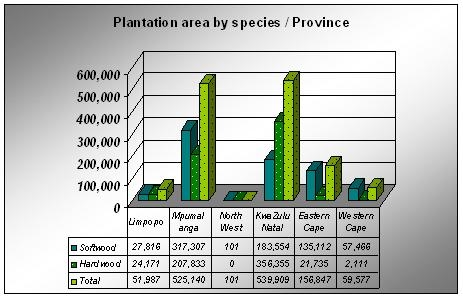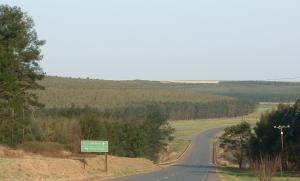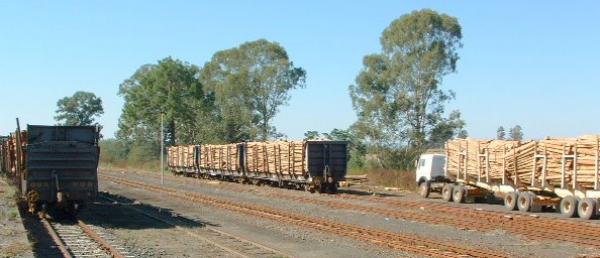 |
ForestryCommercial plantation forestry in South Africa encompasses
large planted forests established to supply raw
materials to satisfy mining, construction and industrial
markets. The forests supply pulp mills, sawmills and
factories which process the raw materials. Wood is a key
raw material to which value is added in many industries
such as: mining; construction of houses and
commercial buildings; poles for electricity distribution
and telecommunications; furniture manufacture; pulp and
paper manufacture; and energy production. LocationThe timber growing areas in KwaZulu-Natal are divided into
5 main afforestation regions which are identified as
Northern Natal, Midlands, Southern Natal, Zululand, and
Maputaland. SpeciesThe main species planted in South Africa are pine (52,2%)
eucalyptus (38,92%) and wattle (8,3%). All of these are
grown in KZN. The dominant form of timber produced is
roundwood that is used for chipping for export. Mainly
hardwood species are used for this purpose.

Maturing Pine
|
The regions with the largest hardwood areas are the
provinces of KwaZulu-Natal (Midlands) and Mpumalanga
South where 49.2% of all hardwoods occur. The dominant
species is eucalyptus grandis which accounts for 51.8% of
the total hardwood area. South African hardwoods are grown
primarily for pulpwood and mining timber production on an
eight to twelve year rotation. Pulpwood is the raw
material for newsprint and kraft paper production.
Softwoods consist mainly of pine species; about 69% of all
softwoods are for sawlog production.
KwaZulu-Natal accounted for 356,355 hectares of hardwood
and 183,554 hectares softwood in 2005.

|
Mature pine, which is becoming increasingly scarce, is
usually reserved for saw-milling due to the high value of
the product (approximately R 500,000 per hectare). It is
noteworthy that the tonnage of sawn timber imported is
rising each year due to the shortage of local supply, and
it is predicted that South Africa will be almost totally
dependent on imports for most sawn timber within the next
ten years. ExtentThe forestry industry in KwaZulu-Natal covers about
740,000 hectares (8.2% of the total area of the province)
with 560,000 hectares already planted
and a further 190,000 hectares of land owned by forestry
organisations unplanted.
A comparison, by province, of the 2004/05 plantation
area is given in the table below.
The reduction in the area under forests is a matter for
concern as the future demand for timber will be
increasingly under-supplied.

Forestry Midlands
|
ValueThe GGP of KZN amounts to about R 57 billion of
which forestry contributes approximately R6.0 billion
(10.7%) through forest products and a further 1.5% through
forestry .
The forestry industry has a capital investment in KwaZulu-
Natal of R14 billion of which R10 billion is in timber
processing and R4 billion in plantations.
The industry is one of the province's largest employers,
absorbing about 43 000 people of the total 2.8 million
labour force. The industry pays R662 million per annum to
staff, and it is estimated that 250 000 people in the
province are in some way dependent on the industry .
If timber processing were to be added to the above figures,
the total impact on employment in the province could be
doubled.
There are currently 10 000 small growers in KZN with an
area of 14 000 hectares under timber and a current
investment of R30 million from which they earn R24 million
per annum. The small grower population is being encouraged
through schemes such as Forests Project ,Grow, Forests
Khulanathi Scheme and the SA Wattle Growers' Union scheme,
which are adding about 2000 new small growers and 3000
hectares each year .

Eucalyptus Plantation
|
From the national perspective the KZN timber industry is
of great importance as 38% of all plantations
and 45% of all new afforestation are in KZN . Nationally,
40% of total plantation output comes from KZN, the wattle
industry is focused in KZN, and 56% of all pulpwood is
produced in the province.
The total roundwood intake during the year 2004/05
was 23 929 382 m³ compared to 22 553 020 m³ in
2003/04.
The value of sales of timber products equalled R15 025
million in 2004/05 compared to R14 815 million for 2003/04.
In 2005, KwaZulu-Natal produced 7,7 million m³ of
hardwood and 2,6 million m³ of softwood. SynergyIn addition to the timber and forestry interests, there
are
also exporters of wattle extract and charcoal from the
Kranskop-Sevenoaks areas which are users of rail and road
for container transport to the port of Durban. Relative importance55% of all timber used in South Africa is processed in KZN
and, of the 13 pulp, paper and board processing plants in
South Africa, 10 are located in KZN. Other industries
that
are significant in KZN due to the presence of the forestry
industry are:
* 2nd largest pulp and paper mill in SA (Richards Bay)
* 2nd largest newsprint mill in SA(Durban)
* world's largest producer of rayon pulp (Umkomaas)
* largest hardboard plant in SA (Estcourt)
* the only 2 SA woodchip export plants (Richards
Bay)
* the 2 largest SA producers of wattle extract
(Hermannsburg and Dalton)
* the 2 largest SA producers of charcoal for export
and local consumption (Dalton-Greytown).
Import-Export VolumesThe KZN forestry industry is a major source of road and
rail freight as well as contributing a significant export
tonnage through the ports of KwaZulu-Natal. Eucalyptus timber and wattle are exported in the form of
woodchips. Wattle timber is used for the manufacture of
pulp. Other important activities are the production of
charcoal and firewood. There are only four woodchip export
facilities in South Africa, three of which are situated in
Richards Bay and one at the port of Durban. According to
the National Port Authority export statistics for 2006/07,
3,728,948 tons of woodchips, 37,641 tons of woodpulp and
83,281 tons of paper-related products were exported
through
the port of Richards Bay.
The woodchipping mill facility located at Maydon Wharf in
the Port of Durban has a capacity of 360,000 air dry
tons of hardwood chips per annum. This woodchip facility
is aimed at the export of eucalyptus hardwood chips from
Durban to pulp and paper manufacturers in Japan. The mill
consists of a totally enclosed woodchip storage shed that
holds 244,000 cubic metres or 80,000 tons of woodchips.
It also features two log decks and two-22 metre, 60-ton
weighbridges for road vehicles and a 100-ton rail
weighbridge. The debarked 2,4 m logs arrive at the plant
via rail and truck where they are fed into an imported
Camura-Metso chipper. A conveyor belt moves the woodchips
to the storage shed with a capacity of 80,000 tons. The
woodchips are conveyed to a ship loader fitted with a jet-
slinger that evenly sprays the chips into the hold. It
takes about four days to load a ship.
In 2006/07 226,716 tons of woodpulp and 395,900 tons of
woodchips were exported through the port of Durban, and in
the first 8 months of 2007 the Durban terminal exported
one million tons of wood chips to Japan.
It should be noted that 68,921 tons of woodpulp were also
imported through Durban in the same year. The bulk of the
timber which comes into South Africa is breakbulk sawn
timber, and 68,921 tons were imported through Durban
harbour in 2006.
The volume transported on the land modes (road and
rail) to processing plants and exported through the ports
is estimated at approximately 10 million tons per annum in
the form of timber and timber-related products, paper,
woodchips,
etc.
Approximately 1,4 million tons of timber are transported
via rail on the KZN branch lines and onto the main lines.
Approximately 108,045 tons of timber are also railed from
Swaziland to Richards Bay on the Durban-Empangeni-Golela
and Swaziland line.
The largest proportion of timber is transported by road
to various processing plants, mills and for export. The
vehicles used are flatdecks with steel stakes or
purpose-designed, stake-sided trailers with the vehicle
configurations of all groups from 5-40 ton
carrying capacity.

Timber on Rail
|
|
 |



